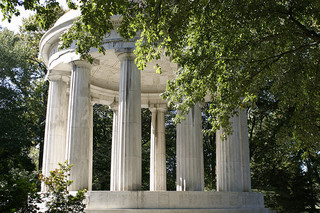From NPS website:
STONES AND THEIR QUARRIES: As a National Park site, the National Mall preserves and protects these great stone symbols. Because of all the building stones, a visit to the National Mall is like a geology field trip across the globe, including rocks from all 50 states!
Where did all the rock on the National Mall come from? Locally quarried stone was used in the early part of Washington, DC’s history because transportation was too difficult to bring in stone from other parts of the country. As railroads expanded in the late 1800s, the choice of building material expanded as well. Suddenly, quarries from around the country were able to supply Washington, DC with rocks that showcased the unique geology of their region. Find out more about each type of rock used in the construction of the National Mall.
You will likely need a magnifying glass, in order to fully appreciate the true grandeur of these stones (especially if you are doing the whole DC M&M Trail). Are you ready?
D.C. WWI MEMORIAL
ROCKS & MINERALS STUDIED HERE: Vermont Imperial Danby marble
Logging Requirement -- N 38 53.250 W 077 02.620
Logging Requirement -- Based on the description below and your observations, which color of vein is present in the marble at the D.C. WWI Memorial? Identify which impurities (minerals) are therefore likely present.

VERMONT DANBY MARBLE:
Marble from Danby, Vermont is known around the world for having a tight grain, white stone, and light veining. There are several color patterns found in Danby Marble, including gold, blue, and green. According to Roadside Geology gold is caused by chert, and/or iron, blue by aquamarine (with iron influence), and green from serpentine. The The Danby Marble is mined and sold in a wide variety including -- Imperial, Montclair, and Royal. Vermont Marble boasts that it is the largest marble mine in the world, with over 25 acres of mine passages/rooms spread over 1 mile underground near Proctor, VT.
Danby marble is a white metamorphic stone of Ordovician age. In eras past, limestone and/or dolomite was buried and subjected to heat and pressure creating this beautiful stone that is rather resilliant to weathering, yet is a stunning white with little "grain."
Wikipedia describes Marble as "a rock resulting from metamorphism of sedimentary carbonate rocks, most commonly limestone or dolomite rock. Metamorphism causes variable recrystallization of the original carbonate mineral grains.
The resulting marble rock is typically composed of an interlocking mosaic of carbonate crystals. Primary sedimentary textures and structures of the original carbonate rock (protolith) have typically been modified or destroyed.
Pure white marble is the result of metamorphism of a very pure (silicate-poor) limestone or dolomite protolith. The characteristic swirls and veins of many colored marble varieties are usually due to various mineral impurities such as clay, silt, sand, iron oxides, or chert which were originally present as grains or layers in the limestone. These various impurities have been mobilized and recrystallized by the intense pressure and heat of the metamorphism.
Please send your answers. Then post a found log. I will contact you if there are any problems or questions about your answers.
Congrads to captainmath for FTF (First to Finish Logging Requirements) on this earthcache!
Resources:
Wikipedia "Marble" http://en.wikipedia.org/wiki/Marble
University of Maryland http://www.geol.umd.edu/courses/geol110/NationalMallGeology.pdf
National Park Service http://nature.nps.gov/geology/parks/
Roadside Geology of Vermont & New Hampshire. Bradford B. Van Diver. 1987.